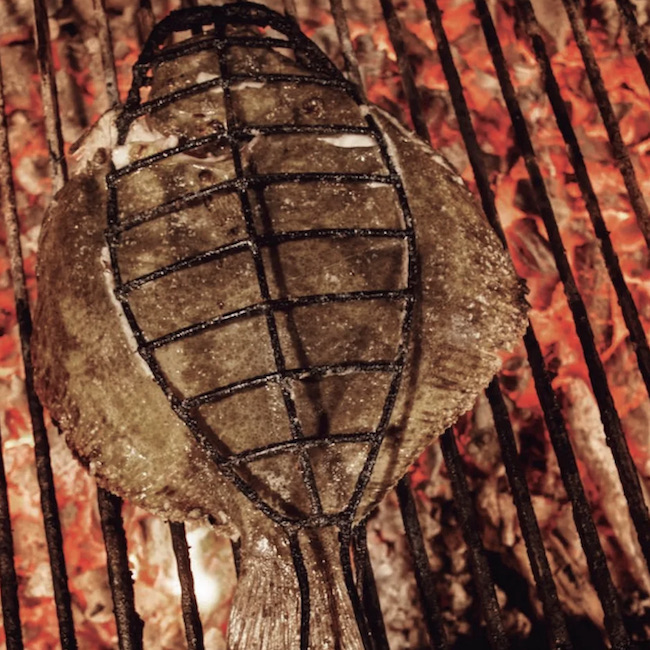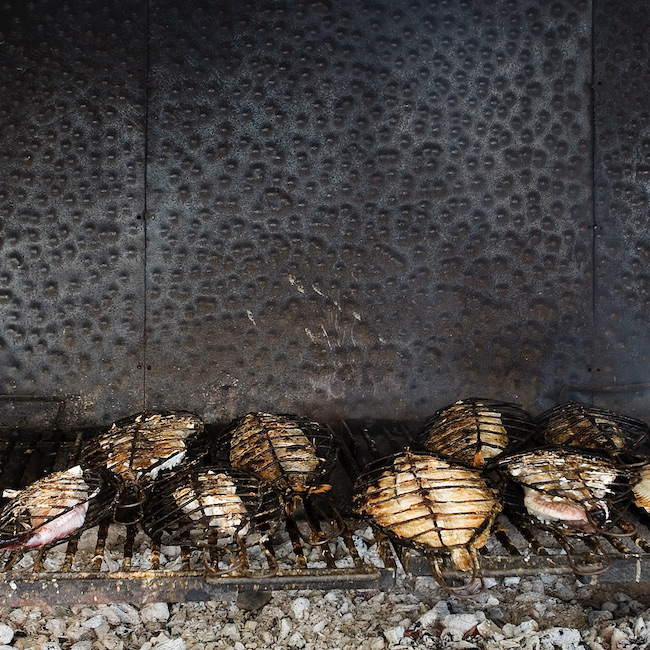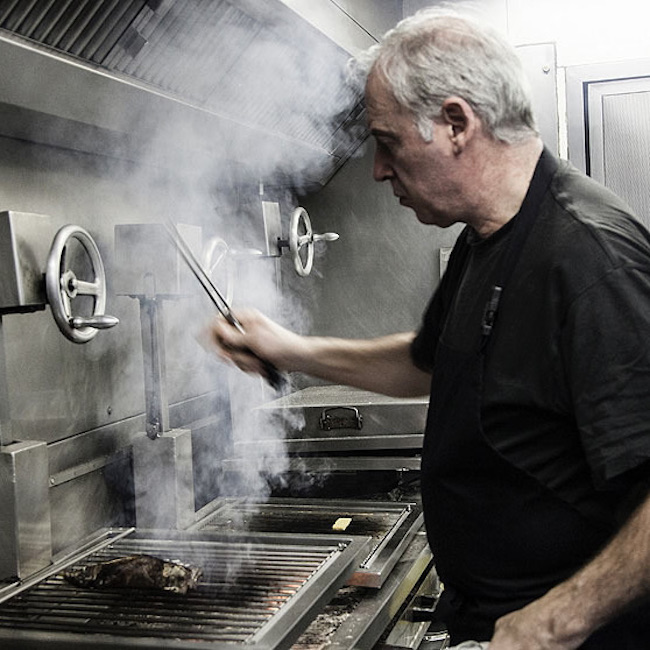by Marti Buckley - @martibuckley
.png.transform/rendition-xs/image_image%20(1).png)
Many of the world’s greatest experts of the grill are in Basque Country. We talk about this centuries-old culinary technique and some of its best representatives

by Marti Buckley - @martibuckley
The grill is synonymous with the origins of cooking. Simple yet exquisite, cooking on the grill involves nothing more than wood, then flames, leaping up to cook a piece of meat. The use of fire as a cooking technique dates back millennia and was key to the evolution of the human species. In the centuries since then, more efficient and easier-to-control forms of heat have taken precedence in the kitchen, and yet—nothing is quite like the grill. And nothing is quite like the grill, or the parrilla, in Spain.
From the steaks at El Capricho in León to the lamp chops at Alameda in Fuenmayor, restaurants in Spain showcase an exceptional talent for cooking over brasas, or coals. Head up to the northern coast around Basque Country, however, and it quickly becomes evident that this corner of the country has a special talent for cooking over a flame. In fact, two of its most famous asadores rank in the top twenty of The World’s 50 Best list: Asador Etxebarri, at #3, and Elkano, at #16. While Etxebarri, under the direction of chef Bittor Arginzoniz, is tucked between craggy stone mountains inland, Elkano is situated just a couple of blocks from the ocean, in the tiny village of Getaria.

Elkano, heart of the tradition
Pulling into Getaria, there is a jai alai court to the right, a fairly ornate town hall, a restaurant in the middle of a fork in the road, and then another building or two before you’re off down the coastal highway to Zumaia — blink and you’ll miss it. You’d be forgiven if you didn’t realize this restaurant, Elkano, forms part of the nucleus of the Basque grilling tradition. Given the size and relative remoteness of the Basque coast, the question remains…why is this corner of Spain so prodigious when it comes to grilled fish?
Basque coastal dwellers live and breathe seafood. They have always had an intimate relationship with the sea, with a roster of some of the world’s most famous naval navigators and fishermen. Recreational fishing is a universally beloved activity, and markets and ports are both abundant and serviced daily with some of the best quality seafood in the world, much of it uber local. A brief glance through any market reveals piles and piles of amazing variety: anchovy, monkfish, tuna, hake, mackerel, mullet, sea bream, turbot, scorpion fish, cod, sardine, sole, squid, spider crab, corvina, razor clams, swordfish, grouper, goose barnacles, octopus, and more. This excellent selection of raw products has led to a style of cooking uniquely Basque—simple, no spices, allowing the excellence of the fish to shine through. And what method of cooking could be better for this than the grill?

His Highness, the ‘rodaballo’
Perhaps the most famous of all these is the grilled rodaballo (turbot), which originated in Getaria. The port and the old town are lined with grills, built into the walls of the buildings with nothing more than a metal basket at thigh height, filled with ash and coals; black grates, and a wheel for adjusting the grill’s height. Grilling fish by the seaside had been a summer tradition for decades if not centuries—sardines in Santurtzi, sea bream in Orio, anchovies in Pasaia.
It was here that Pedro Arregi, one of the masters of the Basque grill, pioneered the grilled turbot. Instead of filleting it, as was customary at the time, Pedro grilled it whole. His wife, Mari Jose, whipped up a vinegar-oil mixture instead of the usual garlicky sauce, a simple liquid that emulsifies perfectly with the fatty oils the turbot releases as it cooks. Known as agua de Lourdes, it is still served today at the restaurant, now run by their son Aitor.
The Basque working the grill sees himself as more of a conduit than a cook. Parrilleros, as they are called, refine their skills over decades. They can look at a fish and determine how much fat it has and, therefore, how it will interact with the flames. They have the feel of the perfect amount of salt in their fingertips’ muscle memories. The Basques know just how to adjust the grill’s height and position and the cook time to perfectly crisp the outside and leave the inside succulent and tender.
If two secrets are amazing product and lifelong dedication of the parrillero, the third is the simplicity and attention to detail. Basque cuisine features an elegant restraint not found in the southern Spain or nearby France. Spices, butter, and heavy sauces are eschewed in favor of nothing more than salt, olive oil, and just maybe a touch of garlic, lemon juice, or parsley. Those behind the grill have one mission in Basque Country: safeguard the natural assets of the meat or fish. Dressings and grilling liquids are kept simple—such as ajilimójili, a sauce of blended and emulsified olive oil, lemon juice, and garlic—and dispensed generously from a plastic bottle, dripping into the flame.

Etxebarri, experimentation and mastery
Now restaurants like Elkano and Etxebarri are at the helm of what could perhaps be referred to in Spanish as the nueva parrilla (“new grilling”) movement. Today, whole lobsters, mushrooms, and even sheep’s milk are fair game for the grill, and the skill of grilling has become an entrenched value in Basque cuisine. From 1990, the movement got a jolt of energy from Bittor Arginzoniz, who began to experiment with the unique qualities of his ingredients, custom-crafting grillware for each item and using carbonized wood that he dry-ages before sealing it hermetically in an oven to begin smoldering. Now, in the 21st century, these masters’ ideas are spreading, all the way to places like Güeyu Mar in Asturias, where seafood gets the kiss of the flames before being canned, and tradition is continued at emblematic establishments like Asador Epeleta in Navarra.
The indisputable ability of the grill to convert the simplest ingredient into pure luxury has resulted in a cuisine that is as at home in mountain huts and busy ports as on the finest white tablecloths of Basque Country.